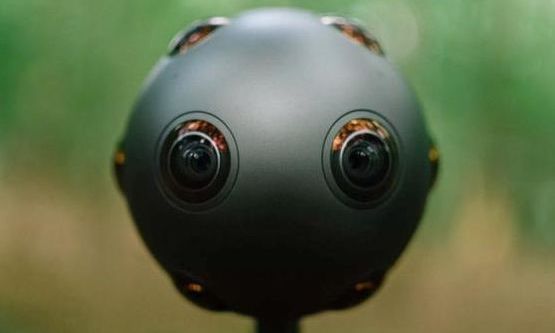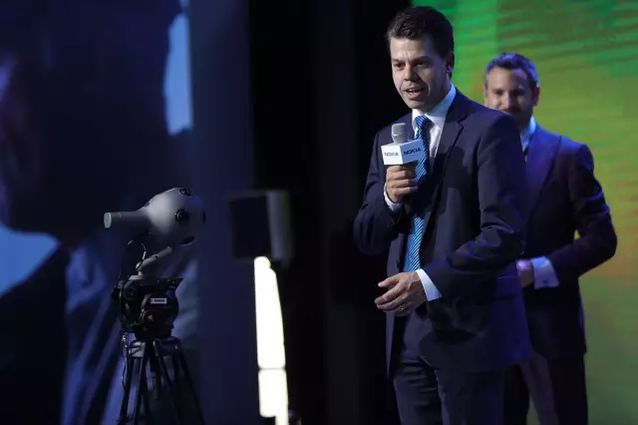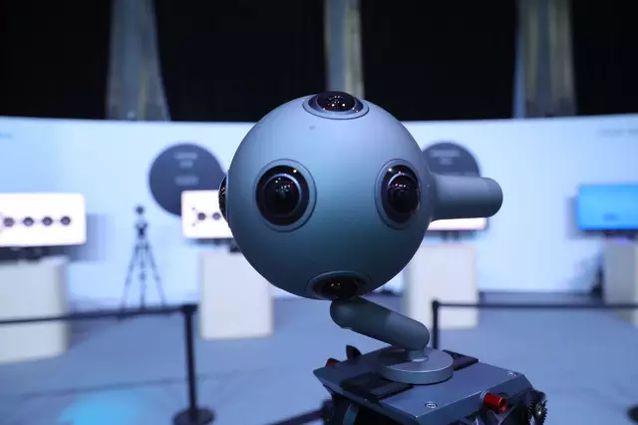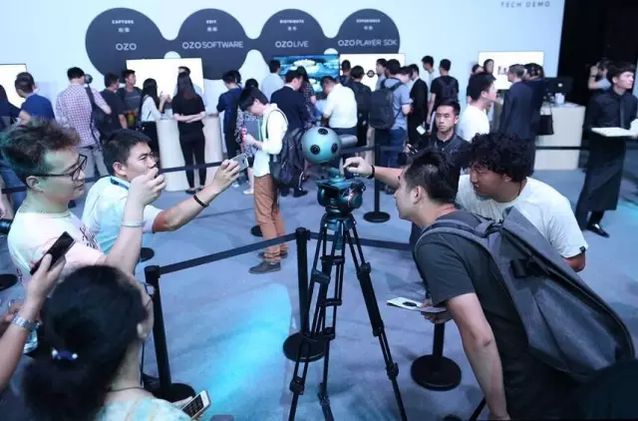Nokia either doesn't shoot, but it always makes a difference.
On August 18, Nokia officially launched the OZO professional VR camera in China. The appearance of this VR camera with exquisite workmanship triggered an exclamation on the spot. In the end, it was Nokia, which could “phone knock on the walnutâ€, and once again demonstrated its strong product strength.
Of course, the most attention on the spot is the price of this professional OZO VR camera, which is priced at 45,000 US dollars in the United States, 40,000 euros in Europe, China's selling price is expected to be consistent with this.

The $45,000 VR camera is a bit weird. However, with the introduction of Ramzi Haidamus, the president of Nokia's technology business, people understand that unlike many VR products for mass-market companies launched by many startup companies, OZO professional VR cameras are aimed at VR content providers.
This all-in-one camera, OZO, enables content creation professionals to easily create great content. As Ramzi Haidamus said, "OZO is tailored to fill this extremely important market gap."

With the launch of OZO products, Nokia announced that the return to the Chinese market partner is LeTV, and plans to release VR content produced by OTV VR.
Although it is a professional-grade VR camera, isn't it 45,000 US dollars too expensive? Isn't it possible for only such heavyweight companies as Letv to cooperate with Nokia? It is undeniable that professional-grade VR cameras have indeed been a market gap, but such an expensive product Can it drive a wider range of VR content production? What is the purpose of Nokia?
This year is actually the year in which the VR industry is breaking. What impact will Nokia's professional-level VR cameras bring to the entire VR industry?
OZO's professional value
Not long ago, Bill Gates released his first VR movie on Facebook in conjunction with his friend Warren Buffett. Although only 4 minutes, VR has once again become a hot topic. Therefore, Nokia's entry into VR is clearly a strategic choice driven by the general trend.
From China's point of view, China's VR enthusiasm is even more fierce than the world. This year, VR has begun to expand to the public domain. “Interesting and enjoyable, isn't it very quickly that we can use these virtual devices to travel around the world at home?†said a middle-aged audience after experiencing VR at the China Telecom Tianyi Trade Fair in early July. At the end of July, Ali's Taobao Creativity Festival, more consumers experienced the fun of VR shopping.
Ms. Tong believes that this year is not only a year in which VR breaks from the industry to the general public, but also VR has become the next investment outlet. A research report predicts that China's VR industry will reach 5.66 billion yuan in 2016, and the market scale is expected to be 2020. More than $55 billion, plus content services and enterprise-class applications, the market capacity is expected to exceed 100 billion yuan.

Mr. Guido Voltolina, head of Nokia's virtual reality department?
Under this trend, Nokia's first step to China's return to China is not the mobile phone business, but it is the first to market VR with more potential and growth potential, and it also shows Nokia's understanding of the Chinese market.
Since it is optimistic about the global and China's VR future, Nokia has naturally come prepared with its product strength has always introduced a professional-grade VR camera. From the presentation at the conference, Nokia's OZO virtual reality camera integrates eight shots, ultimately resulting in a single file, eliminating the need for cumbersome equipment installation and wiring, and the need to synchronize different content on multiple memory cards. Save time. Moreover, OZO's video output requires only one data line, panoramic video and stereo audio are all stored on a single file, and sound and picture are perfectly synchronized. Purchase OZO virtual reality camera also comes with OZO software suite and updates.
These are Nokia's innovations in the product itself, but Nokia's professional-level VR capabilities are even more at the "professional" level, which was previously not achieved by all VR devices.
According to Guido Voltolina, head of Nokia's VR business, OZO Live is a solution specifically designed for VR broadcasts. It captures 360-degree immersive 3D video and stereo audio for a more immersive virtual reality experience. It can break the boundaries of the geographical location and bring a live broadcast experience to the audience.
What's more, OZO Live can be integrated with existing 4K broadcasting equipment, and built-in live splicing function, which can provide broadcast-quality video streams for content production of almost any size. Professional users of VR broadcast production can now watch and switch between a variety of 360-degree viewing modes, creating a stronger sense of presence when broadcasting live events around the world. OZO Live can now be used by some specific partners for presentations or live broadcasts, including a live concert at the premiere of Alice in Wonderland 2: The Adventures of the Universe in Hollywood in May.

It is understood that the OZO Player SDK (software development kit) allows professionals to create unprecedented VR applications and experiences on most mainstream platforms. With the SDK, professionals can create immersive audio-visual applications and experiences to achieve the highest quality playback of OZO content, while also being compatible with standard VR video and audio formats. Nokia supports all major VR platforms and does not restrict any other technology platforms from playing OZO content.
The innovation of the product itself, integration with 4K broadcasting equipment, and elimination of technical barriers with the SDK enable more people to easily create and experience virtual reality. The three points are the professional value of Nokia OZO VR cameras, and they are filled. The professional value of the market blank.
Drive the outbreak of VR content production
In the year when VR broke, it still faces two major obstacles: one is cost and the other is content.
At present, entrepreneurs in the VR industry are mostly concentrated in the hardware field. Representatives of these companies include established terminal giants such as Samsung and HTC, as well as emerging VR startup companies such as Pico, IDEALENS, and DoCo. These companies entering the VR hardware innovation will inevitably bring about a reduction in hardware costs. However, there are many more VR hardware. If there is no VR content development, it is still passive water.
How to break through and upgrade VR content? Unlike all other smart hardware areas, VR content production is more challenging. During the interview with You Yong Tuo Group Co., chairman of the company, Gu Yongzheng, he once stated that VR content production is totally different from traditional video production. With a 360-degree shooting, a main camera must have 24 auxiliary lenses to produce such VR content. Requires real-time cooperation with professional-grade VR hardware.
VR content production has become the core focus of the VR industry's development needs to be the most breakthrough, and this is also the industry value of Nokia professional-grade OZO cameras.
Take this cooperation between Nokia and LeTV as an example. After LeTV released its VR strategy last year, it exerted its efforts on VR hardware. However, the focus of LeTV's VR strategy is precisely on VR content production. This is what LeTV has always had.
As Levi's holding strategy vice president Albuquerque Amitimiti said, VR content will also subvert the traditional content production value chain, adopt a new director model and script, new shooting methods and post-production techniques, there will be A lot of interactive content needs to be completed during the shooting process. And need strong binding with related VR applications.
At present, LeTV has made new breakthroughs in VR content. For example, LeTV has released a lot of VR movies: Experience the magnificent peaks of the Himalayas at 5,205 meters above sea level, and watch the Chinese men's football team and Trinidad and Tobago. Running in the green field, the doors of different rooms were opened to present the scenes of the private idol days.
However, LeTV's VR strategy is more focused, that is, to form a more valuable core breakthrough point with VR content. As a result, LeTV chose to enter into cooperation with Nokia. LeTV VR, an important part of LeTV's ecosystem, will deploy OZO VR solutions on its virtual reality platform to drive further breakthroughs and new outbreaks of LeTV's VR professional content production.

Summary: Nokia's pattern - VR professional content lead strategy
Although Nokia launched a professional-grade VR camera, its high prices are still questioned, because after all, some small startups may find it difficult to buy, and only big companies like LeTV have the strength to cooperate with Nokia.
The real quality of VR content production is actually requiring professional-level equipment. The high price of 45,000 US dollars is not determined by Nokia, but determined by the professionalism of this product. In other words, if you really want to make the most professional VR content, you naturally don't care about the so-called high prices.
From the perspective of industry, when VR develops to a breaking point today, VR content production has become the core focus of industrial development. LeTV has rich content resources and is in need of professional camera equipment to produce its top content in VR content.
Nokia's cooperation with LeTV is the lead for VR top-level and professional content. Only such content can drive the development of VR industry and become a popularization road.
Therefore, it is not difficult to see that Nokia's professional-grade OZO cameras sell not the quantity, but lead the development of VR industry through the leading strategy of professional content. I think that Nokia's road selection is correct. It is high-precision and professional. This is Nokia's advantage.